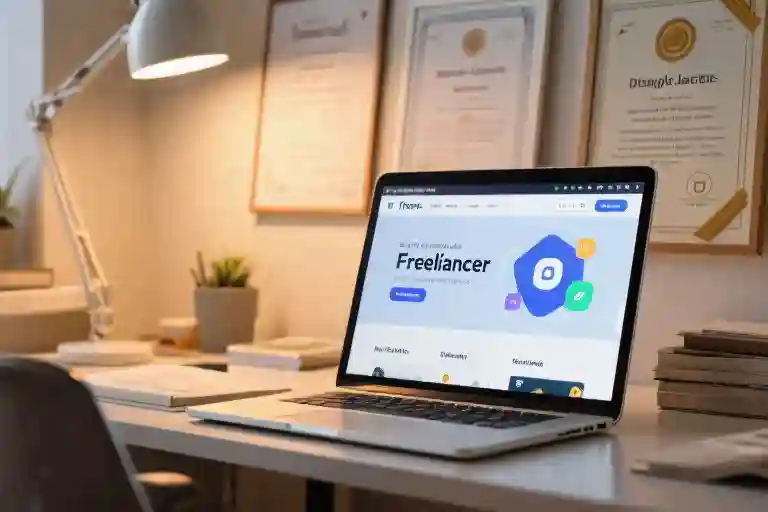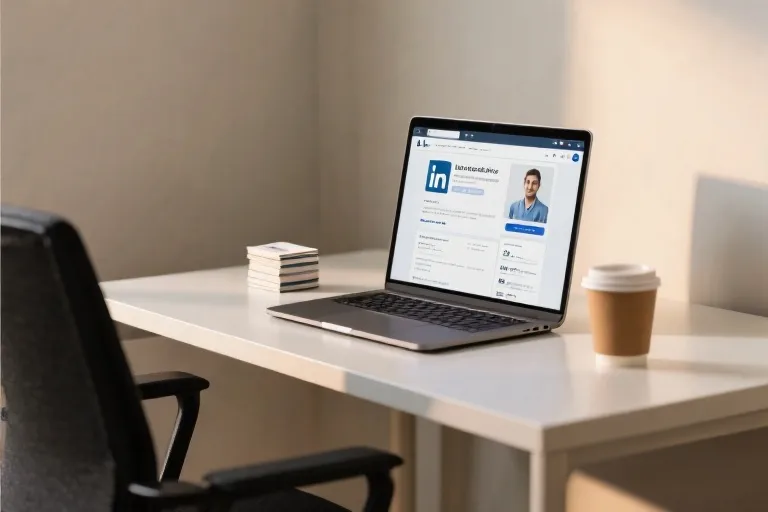The corporate office was quiet except for the hum of fluorescent lights and the occasional ping of arriving emails. I sat staring at my 18th anniversary plaque, the polished wood surface reflecting back a version of myself I barely recognized anymore. That’s when the question surfaced with startling clarity: Why was I still here when everything in me longed to walk away?
Corporate to freelance transition isn’t something that happens overnight. It’s the slow accumulation of realizations – about how you work best, what drains your energy, and where your true value lies. After nearly two decades climbing the corporate ladder (and three painful years managing a software team), three undeniable truths pushed me toward self-employment:
First came the quiet rebellion against being managed. Not in some dramatic, tie-throwing Jerry Maguire moment, but in the daily friction of needing approval for decisions I knew how to make. Corporate America had taught me discipline and accountability, but somewhere around year fifteen, I noticed something peculiar – I didn’t need external structures to produce quality work. Give me clear objectives and autonomy, and I’ll consistently deliver better results than any micromanaged timeline could extract.
Then there was management itself. Nobody warns you how much managing people differs from managing projects. The endless performance reviews, the interpersonal politics, the energy spent herding cats toward consensus – it left me drained in ways my actual work never did. I missed being an independent contributor, where my success depended solely on my own effort and skill.
The final piece emerged unexpectedly through a side project – writing a technical book. When consulting invitations started arriving from companies who’d read my work, I realized something transformative: the market was willing to pay directly for my expertise, without corporate infrastructure as intermediary. Those first few checks weren’t life-changing sums, but they carried disproportionate weight – proof that self-employment for professionals wasn’t just theoretically possible, but immediately viable.
What began as cautious exploration in 1998 has now spanned 25 years of successful independence. Not because I’m exceptionally brave or talented, but because corporate life had quietly prepared me in ways I hadn’t recognized. The discipline to meet deadlines without supervision? Corporate training. The ability to communicate complex ideas clearly? Corporate necessity. The financial prudence to weather uneven income? Corporate paycheck living.
This isn’t a manifesto against traditional employment – different seasons demand different structures. But if you’re reading this while glancing at your own anniversary plaque, perhaps we should examine those three factors together. Because leaving corporate job uncertainty might be the most secure decision you ever make.
The Three Catalysts That Pushed Me Toward Self-Employment
Corporate America had been my home for nearly two decades when I first seriously considered leaving. The cubicles, the performance reviews, the predictable biweekly paychecks – they all felt increasingly like a sweater that had shrunk two sizes too small. What finally tipped the scales wasn’t some dramatic moment of rebellion, but three quiet realizations that accumulated like snow on a branch until the weight became impossible to ignore.
1. The Liberation of Not Needing a Manager
By year eighteen in the corporate world, I’d developed what military folks might call ‘situational awareness.’ Give me clear objectives and reasonable parameters, and I could navigate the terrain without constant oversight. The irony? Most corporate structures assume employees need herding. The weekly check-ins, the progress reports, the layers of approval – what began as helpful guidance started feeling like training wheels on a bicycle I’d long since outgrown.
Freelancing offered something startlingly simple: the freedom to solve problems my way. When a client says ‘We need X by Y date,’ they rarely care about your process – just the result. That shift from being judged on how you work to being valued for what you deliver changes everything. For self-starters who’ve accumulated enough scar tissue from office politics, this alone can justify the leap.
2. The Surprising Toll of Managing Others
Here’s something they don’t warn you about climbing the corporate ladder: each rung requires spending more time managing people and less time doing the work you love. After three years leading a software team, I could chart my declining enthusiasm like a patient’s fever on a hospital whiteboard. The one-on-ones, the performance reviews, mediating disputes about whose code broke the build – it drained me in ways actual programming never did.
What surprised me most wasn’t that management was hard (everyone warns you about that), but how much I missed being an individual contributor. There’s a particular satisfaction in seeing your own work take shape that gets diluted when you’re primarily facilitating others’. Freelancing let me return to that purer form of professional satisfaction – the kind where your hands stay dirty and your accomplishments feel undeniably yours.
3. Proof the Market Would Have Me
All the self-awareness in the world means nothing if clients won’t pay your bills. My safety net came from an unexpected source: a technical book I’d written mostly for fun. The modest royalty checks proved something critical – that complete strangers found my knowledge valuable enough to purchase. Then came consulting inquiries, then training requests. Like a pilot seeing runway lights through fog, these signals gave me just enough visibility to attempt the landing.
Those early income streams weren’t glamorous (my first corporate training gig paid about what I’d make in two days at my salaried job), but they validated the core premise: the market would exchange money for my particular mix of skills. That’s the linchpin no aspiring freelancer should ignore – not passion, not courage, but cold hard evidence that someone’s willing to open their wallet for what you offer.
The Quiet Aftermath
Looking back from twenty-five years in business for myself, what strikes me isn’t how dramatic the transition was, but how natural it felt once these three stars aligned. The corporate safety net wasn’t easy to release, but neither was it holding me up anymore – more like keeping me from moving forward. That’s the peculiar truth about leaving stable employment: by the time all conditions are right, it often feels less like jumping and more like stepping onto ground that’s been rising to meet you all along.
Assessing Your Fit for Freelancing
Making the leap from corporate stability to self-employment isn’t about courage—it’s about fit. After twenty-five years as an independent consultant, I’ve learned freelancing success depends less on your resume and more on three fundamental compatibilities: your personality, your skillset, and your financial runway.
The Self-Management Litmus Test
Corporate environments provide structure—sometimes too much. If you’ve consistently chafed at mandatory meetings or found yourself completing projects weeks ahead of schedule, you might possess the self-direction freelancing requires. Ask yourself:
- Can I create productive routines without external accountability?
- Do I actually enjoy the administrative aspects of my work (scheduling, invoicing, follow-ups)?
- How do I react when facing weeks without client contact?
During my corporate years, I realized I didn’t need managers—just clear objectives. That discovery became my first clue that traditional employment might be wasting my best qualities. The freelancers who thrive are those who see autonomy as fuel, not a threat.
Marketable Skills Versus Corporate Skills
That promotion to management might have actually reduced your freelance viability. Valuable corporate skills—like navigating bureaucracy or running effective meetings—don’t translate to billable hours. Make two lists:
- Directly Monetizable Skills: Technical writing (my gateway), coding, design—anything clients explicitly pay for
- Supporting Skills: Project management, communication—essential but rarely standalone income sources
When I left my software team management position, I had to consciously revert to my individual contributor skills—the very abilities that had gotten me promoted in the first place. Your most valuable freelance assets often predate your highest corporate title.
The Financial Reality Check
Corporate benefits create a hidden salary bump—health insurance, 401(k) matches, even that subsidized cafeteria. Freelancers must cover everything. A simple formula:
Minimum Viable Rate = (Current Annual Salary + 30%) / Billable Hours
That 30% accounts for benefits, taxes, and unbillable time. Most new freelancers underestimate their true costs by 40-60%. I learned this the hard way when my first “lucrative” consulting contract left me earning less than my corporate paycheck after expenses.
Three warning signs you’re not financially ready:
- You can’t articulate your minimum viable rate
- Your savings cover <6 months of living expenses
- You’re counting on “exposure” or “future opportunities” as compensation
Freelancing doesn’t eliminate financial pressures—it redistributes them. The freedom to choose your projects comes with the responsibility to constantly evaluate their true worth.
The Hybrid Experiment
Before burning corporate bridges, try this:
- Dedicate 5-10 weekly hours to freelance work
- Track actual time spent versus billable hours
- Calculate your effective hourly rate after expenses
I transitioned gradually over eighteen months, using vacation days for consulting gigs. This “test drive” revealed unexpected truths—I loved the work but hated client acquisition. That realization shaped my entire business model toward referrals and repeat engagements.
Freelancing isn’t a career upgrade or downgrade—it’s a parallel track with different success metrics. The best freelancers aren’t those escaping bad jobs, but those discovering work that couldn’t exist within traditional employment structures.
Testing the Waters: How to Start Freelancing Without Burning Bridges
Transitioning from corporate stability to freelance freedom doesn’t require an all-or-nothing leap. The smartest corporate-to-freelance transitions I’ve witnessed (including my own in 1998) all shared one strategy: they tested the waters first. Here’s how to explore self-employment while keeping your safety net intact.
The Side Hustle Approach
Platforms like Upwork and Toptal get a bad rap for low-paying gigs, but they serve an important purpose for corporate professionals testing freelance viability. The key is strategic selection:
- Choose projects that mirror your corporate expertise (that ERP implementation skill? Suddenly marketable)
- Limit time investment to 5-10 hours weekly – enough to gauge demand without jeopardizing your day job
- Treat each project as a case study: track actual hours worked vs. corporate hourly wage equivalent
I took my first consulting project while still employed, spending evenings helping a former client’s competitor. The $2,500 project proved two things: 1) My knowledge had standalone value, and 2) I enjoyed the work more without corporate bureaucracy.
Mining Your Corporate Rolodex
Your most valuable freelance asset isn’t your skillset – it’s your professional network. But approaching former colleagues requires finesse:
- Wait 3-6 months after leaving to avoid non-compete issues
- Frame services as ‘special projects’ rather than ongoing work
- Offer introductory rates to first 3 clients in exchange for testimonials
When I transitioned, 80% of my first-year income came from three former Fortune 500 clients. They weren’t buying my technical writing skills – they were buying familiarity with their specific pain points.
The Financial Tipping Point
Conventional wisdom says ‘save six months of expenses.’ For corporate refugees, I suggest a more precise metric: when freelance income consistently covers 30% of your after-tax salary for three consecutive months. Why 30%?
- Accounts for lost benefits (healthcare, 401k matches)
- Creates momentum while maintaining safety net
- Allows time to build referral pipelines
In my case, hitting that 30% threshold took nine months of evenings and weekends. The slow burn felt frustrating at the time, but established sustainable client relationships that lasted decades.
The Corporate Advantage
Don’t underestimate the hidden assets you carry from corporate life:
- Industry-specific knowledge (regulatory frameworks, vendor landscapes)
- Process documentation skills honed in enterprise environments
- Professional communication patterns that clients associate with reliability
Your corporate baggage isn’t a liability – it’s your differentiator in a crowded freelance market. The trick is packaging enterprise experience into standalone services. That PowerPoint deck you grudgingly created? Turns out it’s a $3,000 ‘executive communication workshop’ for small businesses.
When to Make the Leap
The final decision rarely comes down to finances alone. Watch for these emotional indicators:
- You resent your day job for interrupting client work
- Administrative tasks (invoicing, contracts) feel energizing rather than burdensome
- You instinctively frame solutions in ‘project’ rather than ’employee’ terms
I knew it was time when I found myself negotiating a contract during my lunch break instead of eating. Not healthy, perhaps – but telling.
Corporate refugees have one advantage over career freelancers: we know exactly what we’re leaving behind. That awareness forces clearer calculations about what we’re running toward. The safety net you build during this testing phase doesn’t just protect your finances – it reveals whether you truly want to walk the tightrope.
Closing Thoughts: Freelancing as a Conscious Choice
After walking through the three key factors that led me to self-employment and the crucial suitability assessment, one truth stands clear: transitioning from corporate to freelance isn’t about escaping bad jobs—it’s about consciously choosing a different way to work that aligns with who you are.
For me, that alignment came through three realizations: I didn’t need external management structures to be productive, people management drained rather than energized me, and my skills had measurable market value beyond traditional employment. These weren’t fleeting frustrations but fundamental mismatches between corporate life and my working DNA. The past twenty-five years have proven this wasn’t just a reactive move, but the right configuration for how I operate best.
This distinction matters because successful freelancing requires this level of intentionality. It’s not an antidote to bad bosses or office politics—those exist in different forms when you’re self-employed. What makes it work is recognizing, as I did back in 1998, that your professional strengths and personal operating system are better suited to independence. That’s why I still caution corporate friends considering this path: unless you’re moving toward something that fits you, rather than just away from something that doesn’t, the transition will feel perilous.
To help with that discernment, I’ve compiled a Freelance Suitability Checklist drawing from my experience coaching dozens of corporate-to-freelance transitions. It covers the practical considerations—financial runways, skill monetization—but more importantly, it helps surface whether you’ll thrive in the autonomy or wither without structure.
Which brings me to a question I often ask in these conversations: looking back at your corporate skill set, what’s the one capability that clients would readily pay for? For many, it’s not their official job title but some adjacent strength—the engineer who excels at explaining technical concepts, the marketer with a gift for simplifying complex data. That’s usually your freelance foundation.
Mine was taking software concepts and making them accessible—first through that initial book, then through training. Your version of that might be waiting in your current workday, unnoticed because corporations often reward general competence over specialized excellence. Discovering that thread could be your first step toward meaningful independence.
Ultimately, freelancing at its best isn’t just a career change—it’s a reconciliation between how you work and who you are. That’s what made my transition stick. Here’s to finding your version of that fit.





